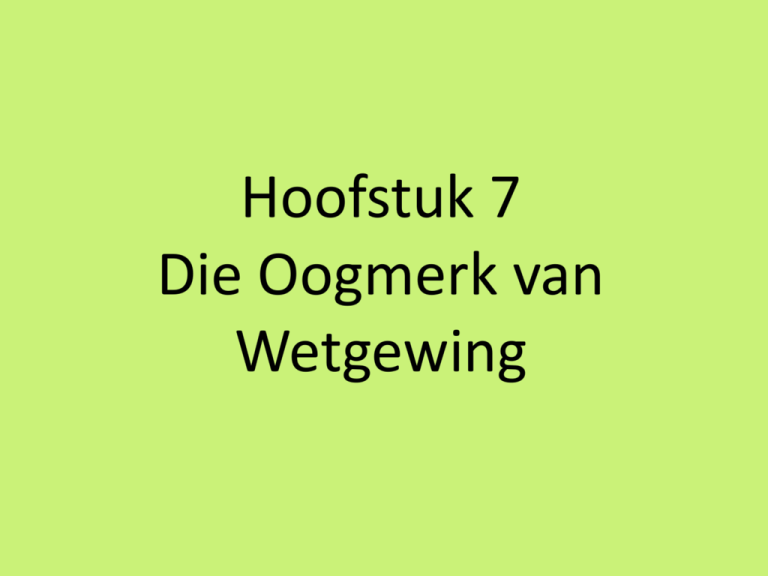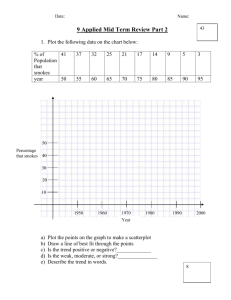Die wetsteks in
advertisement

Hoofstuk 7 Die Oogmerk van Wetgewing Hoofstuk 7 Eksterne hulpmiddels Gemeenregtelike vermoede Interne Hulmiddels Interpretasiewet Wetgewingsoogmerk moet vasgestel word 1. Oogmerk moet vasgestel word in die lig van die gees, strekking en oogmerke van die Handves van Regte in die Grondwet. 2. Hoe? Interne en Eksterne Hulpmiddels Hierdie hoofstuk handel oor hierdie hulpmiddels en die mate waarin hulle gebruik kan word om `n doel te bepaal. Interne Wetgewing en verskillende dele waaruit dit bestaan. Eksterne Wat buite die wetsteks staan. Ander wetgewing, woordeboeke, kommissieverslae. Tektueel Slegs teks Dubbelsinnig Christian Lawyers’ hofsaak? Doeldienend (teks-inkonteks) Interne en Eksterne hulpmiddels van die begin af. Interne en Eksterne hulpmiddels Hof het diskresie om te besluit oor belang en relevansie van spesifieke hulpmiddel Interne Hulpmiddels Die wetsteks in `n ander amptelike landstaal – getekende teks, kritiek Botha Die voorrede – nie net wanneer teks onduidelik is nie, maar van begin af – doeldienende benadering. Die Lang titel – deel van wet wat van begin af oorweeg word – om doel te bepaal. Die definisie-artikel – soos dit staan tensy teenstrydig met konteks. Uitdruklike doeluiteensetting en uitlegriglyne – soms addisionele klousule – Labour Relations Act. Opskrifte bo hoofstukke of artikels – om doel te bepaal Indeling in paragrawe en punktuasie – grammatikale feit – kan doel en mening affekteer. Bylaes – algemene reël. Uitsondering – skedule 4 van Labour Relations Act. Die Teks van wetgewing in `n ander amptelike taal Voor 1996 Grondwet Huwelikswet 1960 AFR Geteken ENG Strafproseswet 1994 ENG Geteken AFR Nuwe wetgewing na 1996 Interpretasiewet ENG – altyd deurslaggewend AFR Die Teks van wetgewing in `n ander amptelike taal ENG WYSIGINGSWET OP HUWELIKE 1990 AFR HUWELIKsWET 1960 AFR WYSIGINGSWET OP HUWELIKE 2000 Eksterne Hulpmiddels Die Grondwet Voorafgaande beraadslagings Omringende omstandighede Woordeboeke en taalkundige getuienis Die bron van `n bepaling Verduidelikende memorandums, voorbeelde en voetnotas Misstandsreël ARTIKEL 9 Diskriminasie Verkry gelykheid Geen gelykheid Artikel 9 van die Grondwet en Regstellende aksie Voorbeelde uit S v Makwanyane No executions have taken place in South Africa since 1989. There are apparently over 300 persons, and possibly as many as 400 if persons sentenced in the former Transkei, Bophuthatswana and Venda are taken into account, who have been sentenced to death by the Courts and who are on death row waiting for this issue to be resolved. Some of these convictions date back to 1988, and approximately half of the persons on death row were sentenced more than two years ago. This is an intolerable situation and it is essential that it be resolved one way or another without further delay. – S v Makwanyane: par 6. [8] Chapter Three of the Constitution sets out the fundamental rights to which every person is entitled under the Constitution and also contains provisions dealing with the way in which the Chapter is to be interpreted by the Courts. It does not deal specifically with the death penalty, but in section 11(2), it prohibits "cruel, inhuman or degrading treatment or punishment." There is no definition of what is to be regarded as "cruel, inhuman or degrading" and we therefore have to give meaning to these words ourselves. - S v Makwanyane: par 8 [12] The written argument of the South African government deals with the debate which took place in regard to the death penalty before the commencement of the constitutional negotiations. The information that it placed before us was not disputed. It was argued that this background information forms part of the context within which the Constitution should be interpreted. [13] Our Courts have held that it is permissible in interpreting a statute to have regard to the purpose and background of the legislation in question. - S v Makwanyane: paras 12-13. [14] Debates in Parliament, including statements made by Ministers responsible for legislation, and explanatory memoranda providing reasons for new bills have not been admitted as background material. It is, however, permissible to take notice of the report of a judicial commission of enquiry for the limited purpose of ascertaining "the mischief aimed at [by] the statutory enactment in question.“ – S v Makwanyane: par 14. [15] As the judgment in Pepper's case shows, a similar relaxation of the exclusionary rule has apparently taken place in Australia and New Zealand. – S v Makwanyane: par 15. The European Court of Human Rights and the United Nations Committee on Human Rights all allow their deliberations to be informed by travaux préparatoires. – S v Makwanyane:par 16 [17] Our Constitution was the product of negotiations conducted at the Multi-Party Negotiating Process. The final draft adopted by the forum of the Multi-Party Negotiating Process was, with few changes, adopted by Parliament. The Multi-Party Negotiating Process was advised by technical committees, and the reports of these committees on the drafts are the equivalent of the travaux préparatoires, relied upon by the international tribunals. Such background material can provide a context for the interpretation of the Constitution and, where it serves that purpose, I can see no reason why such evidence should be excluded. The precise nature of the evidence, and the purpose for which it may be tendered, will determine the weight to be given to it. [22] In August 1991, the South African Law Commission in its Interim Report on Group and Human Rights described the imposition of the death penalty as "highly controversial". A working paper of the Commission which preceded the Interim Report had proposed that the right to life be recognised in a bill of rights, subject to the proviso that the discretionary imposition of the sentence of death be allowed for the most serious crimes. As a result of the comments it received, the Law Commission decided to change the draft and to adopt a "Solomonic solution“… S v Makwanyane:par 22





